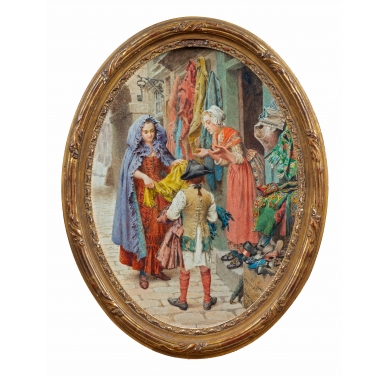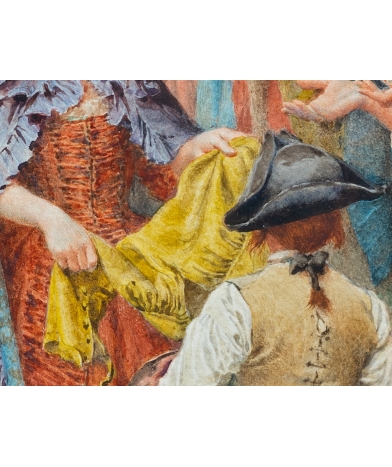Maurice Leloir (1853-1940)
The Fabric Merchant
Dimensions : H. 11 x W. 8.2 inches (With frame: H. 13 x W. 10.2 inches)
Born into a family of painters and illustrators, Maurice Leloir was awarded the second Prix de Rome for his incredible mastery of drawing from an early age. The war of 1870 prevented him from continuing his studies at the Beaux-Arts, and he had to turn to the illustration of classical works, with a strong taste for antique costume, particularly that of the 18th century. He was close to the great academic portraitists of the period, such as Édouard Detaille, Gustave Jacquet, François Flameng...
Leloir was considered the infallible specialist in historical scenes, and as such was sought after by printers for advertising work of all kinds. His signature can be found on images for Le Bon Marché, La Bénédictine, Calvet wine, Clicquot champagne, etc. He received numerous commissions, including the 1903 decoration of Antonin Bordes' villa in Saint-Jean Cap-Ferrat, and the Marquise de Sévigné's tea room on boulevard de la Madeleine. Called to Hollywood by Douglas Fairbanks in 1928, he created the costumes and sets for the film “The Iron Mask”.
From the 1880s onwards, Maurice Leloir was recognized as a painter of “archaeological” meticulousness, and took part in historical museum exhibitions and Universal Expos. In the 1900 exhibition, which gave pride of place to costumes and accessories, Leloir played a leading role. The artist is also world-famous for his illustrations of Alexandre Dumas' novel Les trois Mousquetaires.
This oval watercolor, depicting a scene from Parisian life in the late 18th century, shows just how well Maurice Leloir mastered this difficult technique. A wealthy client, accompanied by her young knight in shining armor, is presented with clothes and fine fabrics. This is exactly the world in which the artist excelled. The finesse of the drawing is remarkable, and the liveliness and diversity of the colors exceptional. It's worth noting its perfect state of preservation, with a total absence of damp stains, and a rare freshness. This watercolor, executed between 1900 and 1920, retains its attractive original gilded wooden frame. Glued to the back is a label from the famous Galeries Georges Petit, where this watercolor was exhibited in 1923 alongside works by the best watercolorists of the period.
Museums:
Paris, Musée de l’Armée
Paris, Bibliothèque Nationale de France
Bibliography:
E. Bénézit, Dictionnaire des peintres, sculpteurs, dessinateurs
et graveurs, Gründ edition, 1999, tome 8, page 477.
 Maurice Leloir - The Pont au Change, Paris - Paris, BnF
Maurice Leloir - The Pont au Change, Paris - Paris, BnF






